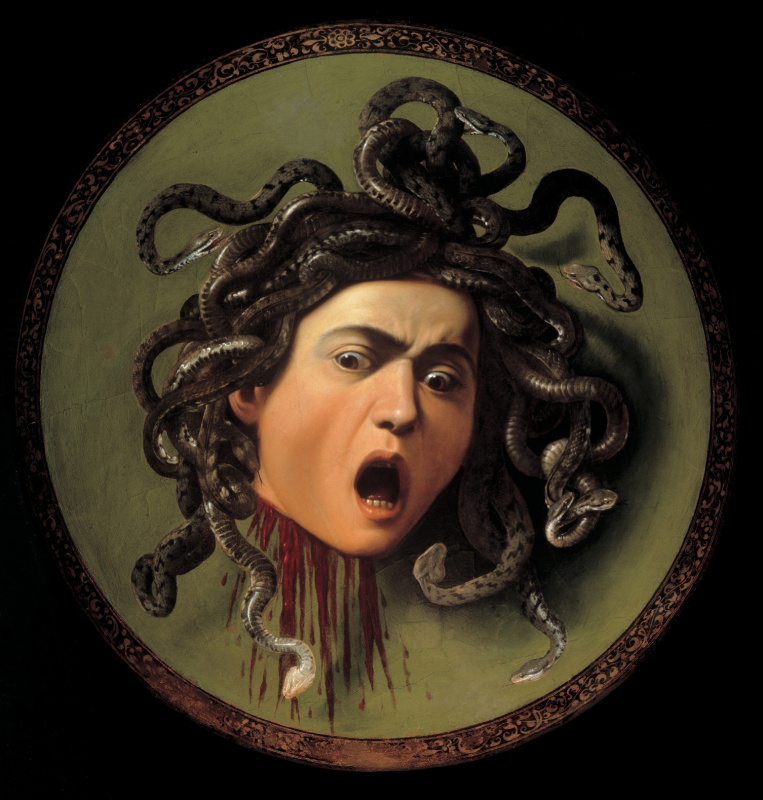log in
Enter site
Login to use Arthive functionality to the maximum
Medusa
Michelangelo Merisi de Caravaggio • Painting, 1597, 60×55 cm
Description of the artwork «Medusa»
Stories from Greek mythology was very popular among painters of the Late Renaissance. One of the characters in these myths, has attracted the attention of such famous artists as Rubens and Leonardo da Vinci, was a Gorgon — a monster with snakes instead of hair, framing a woman's face. According to legend, any living creature who looked Medusa in the eye, immediately turned to stone. This ability leaves no chance to its enemies and made the Gorgon practically invulnerable. Only Perseus, carrying out the instructions of the king Polidekt, managed to outwit the monster: he attacked Medusa, looking at her reflection in his brazen shield, and cut off her head.
It turned out that even after death, Medusa was dangerous: her dead eyes has not lost its strength and was still able to turn anyone into a stone statue. Such we can see it in the painting by Caravaggio, depicting the severed head of Medusa defeated, but continued to bring death.
Commissioned to create this canvas Caravaggio received in 1597 by cardinal Francesco Del Monte, who planned to present the Duke de Medici unusual gift: the picture on the subject of Ovid, written in a round shield. The artist enthusiastically set to work: he might have been motivated by a sense of rivalry with the great Leonardo, who also tried to transfer to canvas the events of the ancient myth. The picture "Medusa"that we invite you to read, Caravaggio was written in record time: a year later, in 1598, the work was presented to the Duke.
As you know, the artist painted his canvas without preliminary sketches: x-ray analysis of the canvas does not find in them traces of pencil or charcoal. Head of Medusa painted by Caravaggio on canvas, stretched on a round wooden Board, was also created without a single sketch, so it was believed until the late twentieth century. Some doubts among critics was the fact that in one private collection was almost an exact copy of the painting "Medusa", however, to verify it was only in the 90-ies of the last century.
The analysis showed that Caravaggio did a trial version of the picture: they were the head of Medusa, painted on the shield of smaller diameter. Under a layer of paint clearly visible outline of the coal, over which the master has left a light sketch with a brush. Experts managed to see what was hidden from prying eyes: painting-charcoal sketch suggested that the Medusa is depicted as a grotesque theatrical masks, but then the artist chose to give the monster human qualities.
To portray on the convex surface of the shield beautiful female face, the artist used popular methods of copying with mirrors and glass. For the contemporaries of Caravaggio's painting "Medusa" was an undoubted masterpiece, despite the grim tone, the flow of blood and drama. Today, this masterpiece of fine art adorns the Uffizi gallery in Florence.
It turned out that even after death, Medusa was dangerous: her dead eyes has not lost its strength and was still able to turn anyone into a stone statue. Such we can see it in the painting by Caravaggio, depicting the severed head of Medusa defeated, but continued to bring death.
Commissioned to create this canvas Caravaggio received in 1597 by cardinal Francesco Del Monte, who planned to present the Duke de Medici unusual gift: the picture on the subject of Ovid, written in a round shield. The artist enthusiastically set to work: he might have been motivated by a sense of rivalry with the great Leonardo, who also tried to transfer to canvas the events of the ancient myth. The picture "Medusa"that we invite you to read, Caravaggio was written in record time: a year later, in 1598, the work was presented to the Duke.
As you know, the artist painted his canvas without preliminary sketches: x-ray analysis of the canvas does not find in them traces of pencil or charcoal. Head of Medusa painted by Caravaggio on canvas, stretched on a round wooden Board, was also created without a single sketch, so it was believed until the late twentieth century. Some doubts among critics was the fact that in one private collection was almost an exact copy of the painting "Medusa", however, to verify it was only in the 90-ies of the last century.
The analysis showed that Caravaggio did a trial version of the picture: they were the head of Medusa, painted on the shield of smaller diameter. Under a layer of paint clearly visible outline of the coal, over which the master has left a light sketch with a brush. Experts managed to see what was hidden from prying eyes: painting-charcoal sketch suggested that the Medusa is depicted as a grotesque theatrical masks, but then the artist chose to give the monster human qualities.
To portray on the convex surface of the shield beautiful female face, the artist used popular methods of copying with mirrors and glass. For the contemporaries of Caravaggio's painting "Medusa" was an undoubted masterpiece, despite the grim tone, the flow of blood and drama. Today, this masterpiece of fine art adorns the Uffizi gallery in Florence.


